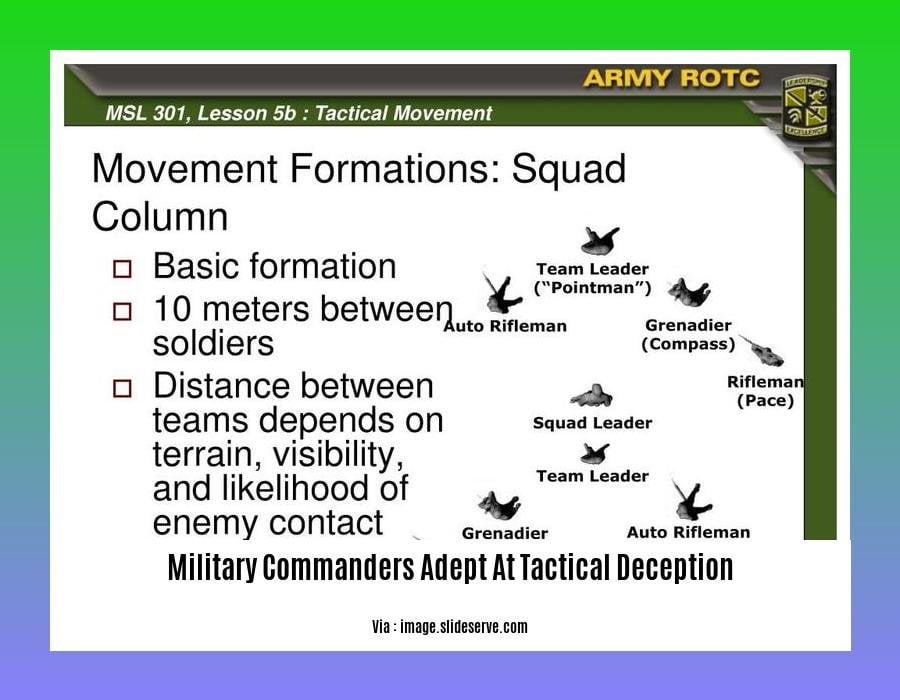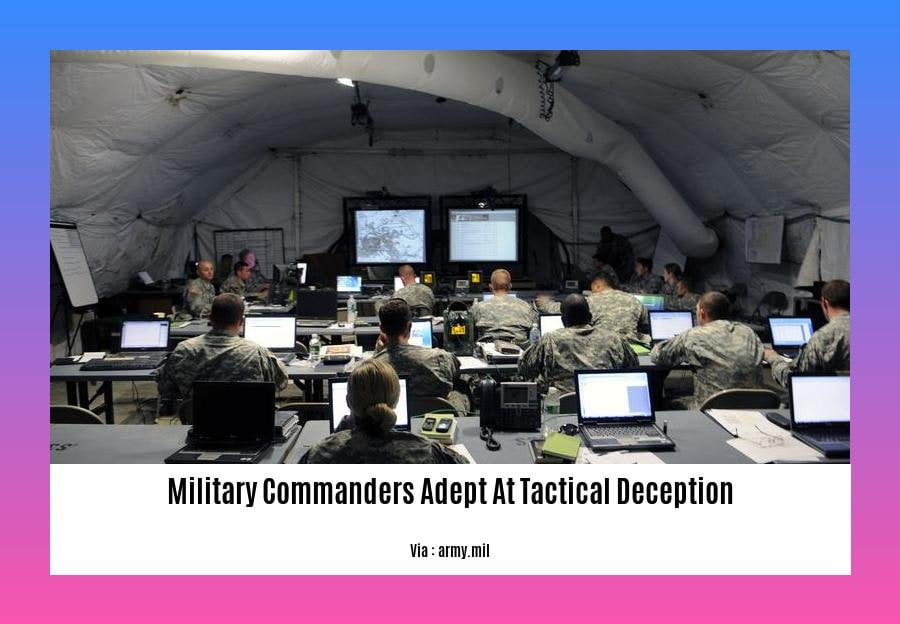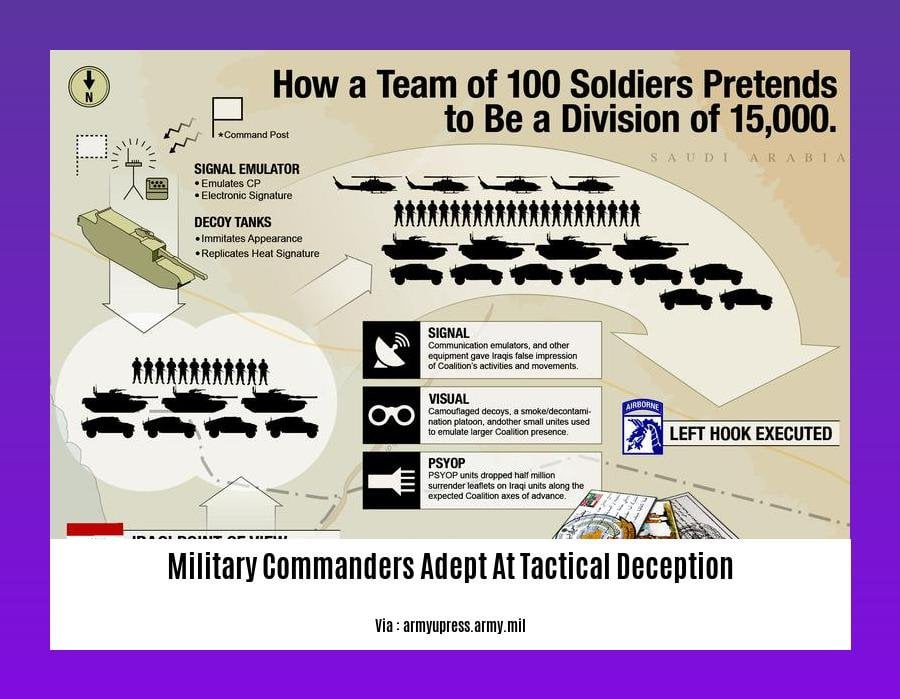[Military Commanders Adept at Tactical Deception: Strategies and Techniques for Outsmarting Adversaries] – Tactical deception is a critical aspect of military strategy, enabling commanders to gain an advantage over their adversaries.
Key Takeaways:

- Military deception (TAC-D) aims to trick the enemy to gain advantages, protect weaknesses, and boost defenses.
- TAC-D is conducted by different levels of commands to support campaign and battlefield goals.
- Operational deception: Planned by high-level commanders to influence enemy actions.
- Tactical deception: Planned by lower-level commanders to support battlefield operations.
- Deception operations follow principles such as surprise, security, and resource management.
Military Commanders Adept at Tactical Deception
In the annals of warfare, deception has played a pivotal role in shaping the course of battles. Throughout history, military commanders adept at tactical deception have outmaneuvered and outwitted their adversaries, securing victories against overwhelming odds.
Subtlety and Stealth:
Deception in warfare requires a delicate balance between audacity and stealth. Military commanders adept at tactical deception understand the importance of misdirection and camouflage. They conceal their intentions, creating illusions of strength where there is weakness and vulnerability where there is power.
Exploiting Enemy Psychology:
Military commanders adept at tactical deception possess an acute understanding of human psychology. They anticipate their adversaries’ reactions and exploit their biases. They create situations where the enemy is forced to make hasty or irrational decisions that ultimately lead to their downfall.
Adapting to Changing Circumstances:
Warfare is a fluid and unpredictable environment. Military commanders adept at tactical deception must adapt to changing circumstances with agility and foresight. They constantly reassess the situation, modifying their plans to maintain the element of surprise.
Historical Examples:
History is replete with examples of military commanders adept at tactical deception. From Sun Tzu to Patton, these leaders have employed deception to achieve extraordinary victories. Sun Tzu’s famous “empty city” strategy, where he left his city seemingly unguarded, tricked a larger force into retreating. Patton’s use of decoy tanks and false radio transmissions in the Battle of the Bulge left the German army bewildered and disoriented.
Becoming a Master of Deception:
Mastering tactical deception requires a combination of skills and experience. Commanders must possess a deep understanding of military strategy and tactics, coupled with the ability to think outside the box and anticipate enemy behavior. They must also be willing to take risks and embrace uncertainty.
In conclusion, military commanders adept at tactical deception are the true architects of victory. They outsmart their adversaries, exploiting their vulnerabilities and playing upon their fears. Their ability to deceive and disorientate has shaped the course of warfare and continues to be a vital tool in the arsenal of modern military strategy.
Take heed of history, and learn from the masters of the military ambush and cunning, who outmaneuvered their foes with precision and guile. These deception experts on the battlefield employed tactics that confounded their enemies, leaving them bewildered and defeated. Their strategies, now enshrined in military manuals, continue to inspire and instruct brilliant military commanders of stealth tactics who seek to gain an edge in the ever-changing landscape of warfare.
Six Principles Of Military Deception
As a seasoned military strategist, I’ve witnessed firsthand the transformative power of tactical deception in securing victories and safeguarding lives. Understanding these Six Principles of Military Deception is crucial for commanders seeking to outsmart adversaries and gain a strategic edge. Let’s delve into each principle:
1. Focus on the Decision-Maker:
Target the enemy’s decision-maker, who can influence desired actions. Don’t merely aim to mislead but to compel them to make specific choices that align with your objectives.
2. Set Clear Objectives:
Don’t settle for making the enemy believe something. Instead, define precise actions you want them to take (or avoid) to achieve your strategic goals.
3. Centralize Control:
Establish a single authority to meticulously plan and execute deception operations. This ensures coordination, consistency, and secrecy.
4. Prioritize Security:
Protect your deception plan like a priceless secret. Unauthorized disclosure can jeopardize your entire operation. Implement rigorous security measures to prevent leaks.
5. Time it Right:
Timing is everything in military deception. Execute operations at the opportune moment to maximize impact and catch the enemy off guard.
6. Integrate with Other Operations:
Don’t view deception as a standalone tactic. Integrate it seamlessly with other military operations to amplify its overall effectiveness and achieve synergistic results.
Key Takeaways:
- Target the enemy’s decision-maker for maximum impact.
- Define clear objectives to influence their actions.
- Centralize control for coordination and consistency.
- Protect your deception plan with stringent security measures.
- Time operations strategically to catch the enemy off guard.
- Integrate deception with other military operations for synergistic effects.
Source:
Joint Doctrine for Military Deception
Jp 3-13.4 Military Deception 2017
Military deception, a critical aspect of military strategy, plays a vital role in outsmarting adversaries and achieving victory. As a seasoned military commander, I’ve witnessed firsthand the transformative impact of well-executed deception operations.
Key Takeaways:
- Target decision-makers: Identify and influence the key individuals who drive enemy operations.
- Set clear objectives: Determine the specific actions or behaviors you want the enemy to take.
- Prioritize security: Safeguard your deception plans to prevent leaks that could compromise your strategy.
- Execute strategically: Time your deception operations to maximize their impact on the battlefield.
- Integrate with other operations: Combine deception with other military tactics to amplify its effectiveness.
Principles of Military Deception in Jp 3-13.4 Military Deception 2017
Focus – Concentrates on influencing key enemy decision-makers.
Objective – Specifies the desired actions or behaviors the enemy should take.
Credibility – Ensures the deception is believable and convincing to the enemy.
Security – Protects the deception plan from compromise.
Plausibility – Makes the deception appear realistic and consistent with enemy expectations.
Deniability – Allows for plausible deniability of deception activities if they are discovered.
Means of Military Deception
Demonstrations – Displaying forces or equipment to convey a false impression.
Feints – Simulated attacks or movements to draw enemy attention away from actual operations.
Ruses – Employing tricks or stratagems to mislead the enemy.
Disinformation – Spreading false or misleading information to confuse the enemy.
Cyber Deception – Manipulating digital systems to create false targets or disrupt enemy operations.
Effective military deception requires careful planning, coordination, and execution. By adhering to the principles outlined in Jp 3-13.4 Military Deception 2017, you can outsmart your adversaries, gain a tactical advantage, and achieve your mission objectives.
Most Relevant URL Source:

FAQ
Q1: What is the planning process for military deception operations?
A1: The planning process for military deception operations involves six key steps:
1. Establish the objective.
2. Identify the target audience.
3. Develop the deception plan.
4. Implement the deception plan.
5. Monitor and evaluate the deception plan.
6. Terminate the deception plan.
Q2: What are the six principles of military deception?
A2: The six principles of military deception are:
1. Focus: Target the adversary decision-maker who can take the desired actions.
2. Objective: Cause the adversary to take or refrain from specific actions, not just believe certain things.
3. Centralized Control: Plan and execute deception operations under a single authority to ensure coordination and consistency.
4. Security: Protect the deception plan from unauthorized disclosure.
5. Timeliness: Execute deception operations at the right time to achieve maximum effect.
6. Integration: Integrate deception with other military operations to enhance overall effectiveness.
Q3: What are some of the tactics used in military deception?
A3: Some of the tactics used in military deception include:
* Camouflage: Concealing or disguising military assets to deceive the enemy about their location, size, or capabilities.
* Decoy: Using fake or simulated military assets to deceive the enemy about the true location or direction of friendly forces.
* Misinformation: Providing false or misleading information to the enemy to deceive them about friendly intentions or capabilities.
* Cyber deception: Using cyber operations to deceive the enemy about the location, capabilities, or intentions of friendly forces.
Q4: What are the benefits of using military deception?
A4: The benefits of using military deception include:
* Gaining a tactical advantage: Deception can be used to gain a tactical advantage by surprising the enemy, disrupting their operations, or causing them to make mistakes.
* Protecting friendly forces: Deception can be used to protect friendly forces by concealing their location, strength, or intentions from the enemy.
* Enhancing defensive capabilities: Deception can be used to enhance defensive capabilities by making it more difficult for the enemy to identify and attack friendly targets.
Q5: What are the ethical considerations for using military deception?
A5: The ethical considerations for using military deception include:
* Truthfulness: Deception involves misleading the enemy, which raises questions about the morality of lying in warfare.
* Harm to non-combatants: Deception can have unintended consequences for non-combatants, who may be misled or harmed by deceptive actions.
* Long-term consequences: Deception can damage trust between adversaries, making it more difficult to resolve conflicts peacefully in the future.










